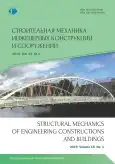System of insufficiency of the modern theory of long-term resistance of reinforced concrete and designers’ warnings
- Authors: Sanzharovsky R.S1, Manchenko M.M2, Hadzhiev M.A3, Musabaev T.T1, Ter-Emmanuilyan T.N4, Varenik K.A5
-
Affiliations:
- L.N. Gumilyov Eurasian National University
- Krylov State Research Center
- Azerbaijan University of Architecture and Construction
- Russian University of Transport
- Yaroslav-the-Wise Novgorod State University
- Issue: Vol 15, No 1 (2019)
- Pages: 3-24
- Section: Analysis and design of building structures
- URL: https://journal-vniispk.ru/1815-5235/article/view/346251
- DOI: https://doi.org/10.22363/1815-5235-2019-15-1-3-24
- ID: 346251
Cite item
Full Text
Abstract
Aim of the research. The essence of the failure of the globally widespread theory of long-term resistance of reinforced concrete is defined and analyzed. Methods. This failure includes the following interconnected parts: 1) the set of ten basic fundamental properties of structural concrete is completely distorted (for example, instantaneous linear properties are Maxwell scheme); 2) mathematical rules are violated when recording the rates of elastic deformation and creep deformation, due to a misunderstanding of the Boltzmann principle (these violations distort the whole structure of the theory); 3) the rules of classical mechanics are violated, what is caused by substitution of fundamental properties of concrete with various “chain models” (for example, the principle of independence of action of forces, which is the fourth fundamental law of Galileo - Newton, is violated); 4) sections of the general “world theory of creep of reinforced concrete”, based on its algebraization, in their essence reject the fundamental law of natural science - Newton's second law: not only the inertial component is rejected, but also forces depending on speed (in this way the “world theory of creep of reinforced concrete” is degraded to the level of Aristotle’s mechanics); 5) unacceptably idealized creep theories and structural models that endow concrete with unrealizable properties, especially flagrant in zones of cracks, are incorporated in the normative calculations of structures; 6) solid design companies of the world show that concrete creep is not a scientific theory: this is a warning to designers. Results. The performed analysis is accompanied by necessary mathematical calculations and experimental estimates.
About the authors
Rudolf S Sanzharovsky
L.N. Gumilyov Eurasian National University
Author for correspondence.
Email: manchenko.se@gmail.com
D.Sc. in Technical Scien- ces, Professor, Senior Research Fellow
11 Kazhymukana St., Astana, 010000, Republic of KazakhstanMaxim M Manchenko
Krylov State Research Center
Email: manchenko.se@gmail.com
PhD in Technical Sciences, Senior Research Fellow
44 Moskovsky Prospekt, Saint Petersburg, 196158, Russian FederationMuhlis A Hadzhiev
Azerbaijan University of Architecture and Construction
Email: tanya_ter@mail.ru
D.Sc. in Technical Sciences, Professor, Head of the Department of Building Structure
11 Ayna Sultanova St., Baku, AZ1073, Republic of AzerbaijanTurlybek T Musabaev
L.N. Gumilyov Eurasian National University
Email: manchenko.se@gmail.com
D.Sc. in Technical Scien- ces, Professor, Academician, Director of the Eurasian Institute of Technology
2 Satpayev St., Astana, 010000, Republic of KazakhstanTatyana N Ter-Emmanuilyan
Russian University of Transport
Email: tanya_ter@mail.ru
Doctor of Technical Sciences, Professor of the Department of Theoretical Mechanics
9 Obrazcova St., bldg. 9, Moscow, 127994, Russian FederationKirill A Varenik
Yaroslav-the-Wise Novgorod State University
Email: vkirillv89@mail.ru
PhD in Technical Sciences, Associate Professor
41 Big Saint Petersburg St., Velikiy Novgorod, 173003, Russian FederationReferences
- Chiorino M.A. (2014). Analysis of structural effects of time-dependent behavior of concrete: an internationally harmonized format. Concrete and Reinforced concrete – Glance at Future. Plenary papers of III All Russian (International) Conference on Concrete and Reinforced Concrete, Moscow, 2014. Vol. 7. 338–350.
- FIB, Model Code for Concrete Structures 2010. (2013). Ernst & Sohn, 402.
- Chiorino M.A. (Chairm. of Edit. Team). (March 2011). ACI 209.3R-XX. Analysis of Creep and Shrinkage Effects on Concrete Structures. Final Draft. ACI Committee 209. 228.
- Gordon Klark. (2014). Vyzovy vysotnyh zdanij [Challenges of high-rise buildings]. Industriya. Inzhenernaya gazeta, (11–12). (In Russ.)
- EN 1992-2 2004. Eurocode 2: Design of constructions.
- McHenry H.I. (1943). A new aspect of creep in concrete and its application to design. Proc. A.S.T.M., (40), 1069–1084.
- Leaderman H. (1943). Elastic and creep properties of filamentous and other high polymers. Textile Foundation. Washington, 278.
- GOSSTROJ USSR; NIIZB. (1976). Polzuchest' i usadka betona i zhelezobetonnyh konstrukcij. Sostoyanie problemy i perspektivy razvitiya [Creep and shrinkage of concrete and reinforced concrete structures. State of the problem and development prospects]. Moscow: Strojizdat Publ., 351. (In Russ.)
- Sanjarovsky R., Manchenko M. (2016). Errors in the theory of creep of reinforced concrete and modern norms. Structural Mechanics of Engineering Constructions and Buildings, (3), 25–32.
- Sanjarovskiy R., Ter-Emmanuilyan T., Manchenko M. (2015). Creep of Concrete and Its Instant Nonlinear Deformation in the Calculation of Structures. CONCREEP 10, 238–247.
- Sanzharovskij R.S., Manchenko M.M. (2017). Errors of international standards on reinforced concrete and rules of the Eurocode. Structural Mechanics of Engineering Constructions and Buildings, (6), 25–36.
- Veryuzhskij Yu.V., Golyshev A.B., Kolchunov Vl.I., Klyueva N.V., Lisicin B.M., Mashkov I.L., Yakovenko I.A. (2014). Spravochnoe posobie po stroitel'noj mekhanike. T. I [Reference manual for structural mechanics. Vol. I]. Moscow: ASV Publ., 506–508. (In Russ.)
- Rabotnov Yu.N. (1977). Elementy nasledstvennoj mekhaniki tverdyh tel [Elements of hereditary solid mechanics]. Moscow: Nauka Publ., 383. (In Russ.)
- Gvozdev A.A. (1955). Polzuchest' betona i puti ee issledovaniya [The creep of concrete and its research paths]. Issledovaniya prochnosti, plastichnosti i polzuchesti stroitel'nyh materialov [Studies of strength, plasticity and creep of building materials]. Moscow, 126–137.
- Sanzharovsky R.S., Ter-Emmanuilyan T.N., Manchenko M.M. (2018). Superposition principle as the fundamental error of the creep theory and standards of the reinforced concrete. Structural Mechanics of Engineering Constructions and Buildings, 14(2), 92–104. doi: 10.22363/ 1815-5235-2018-14-2-92-104
- Sanzharovskij R.S. (1984). Ustojchivost' ehlementov stroitel'nyh konstrukcij pri polzuchesti [The stability of the elements of building structures in creep.]. Leningrad: LGU Publ., 280. (In Russ.)
- Varenik K.A., Sanzharovskij R.S., Varenik A.S. (2014). Ustojchivost' szhatyh derevyannyh konstrukcij s uchetom mgnovennoj nelinejnosti i nelinejnoj polzuchesti [Stability of compressed wooden structures taking into account instantaneous nonlinearity and nonlinear creep]. Nauchnoe obozrenie, 8(2), 572–575. (In Russ.)
Supplementary files









